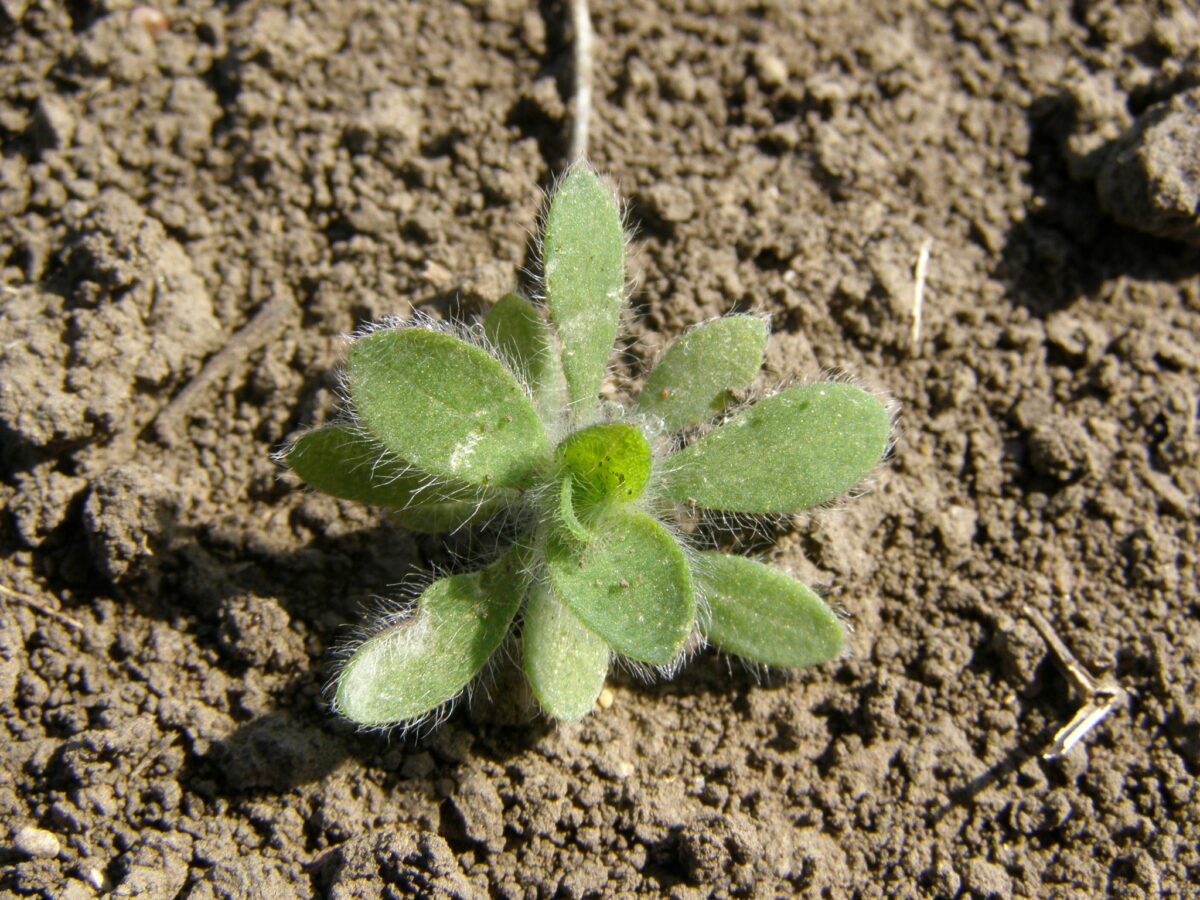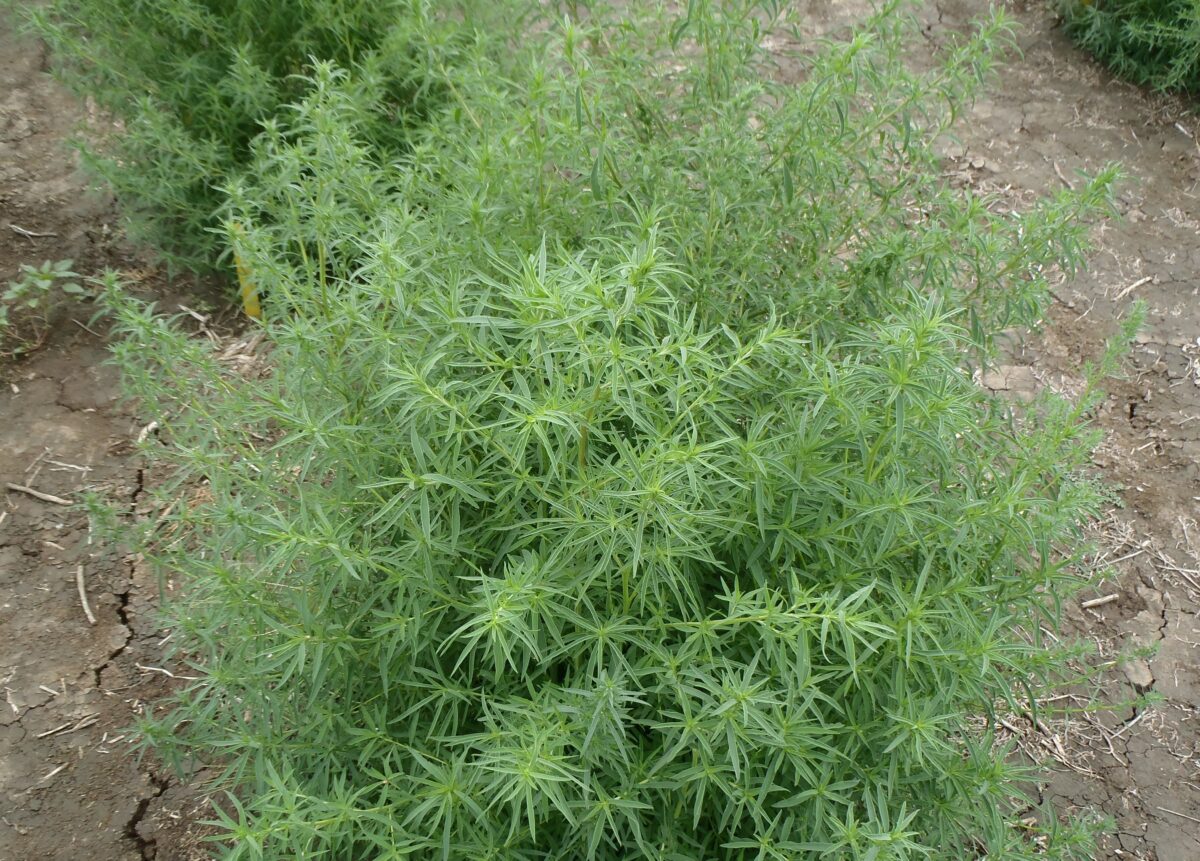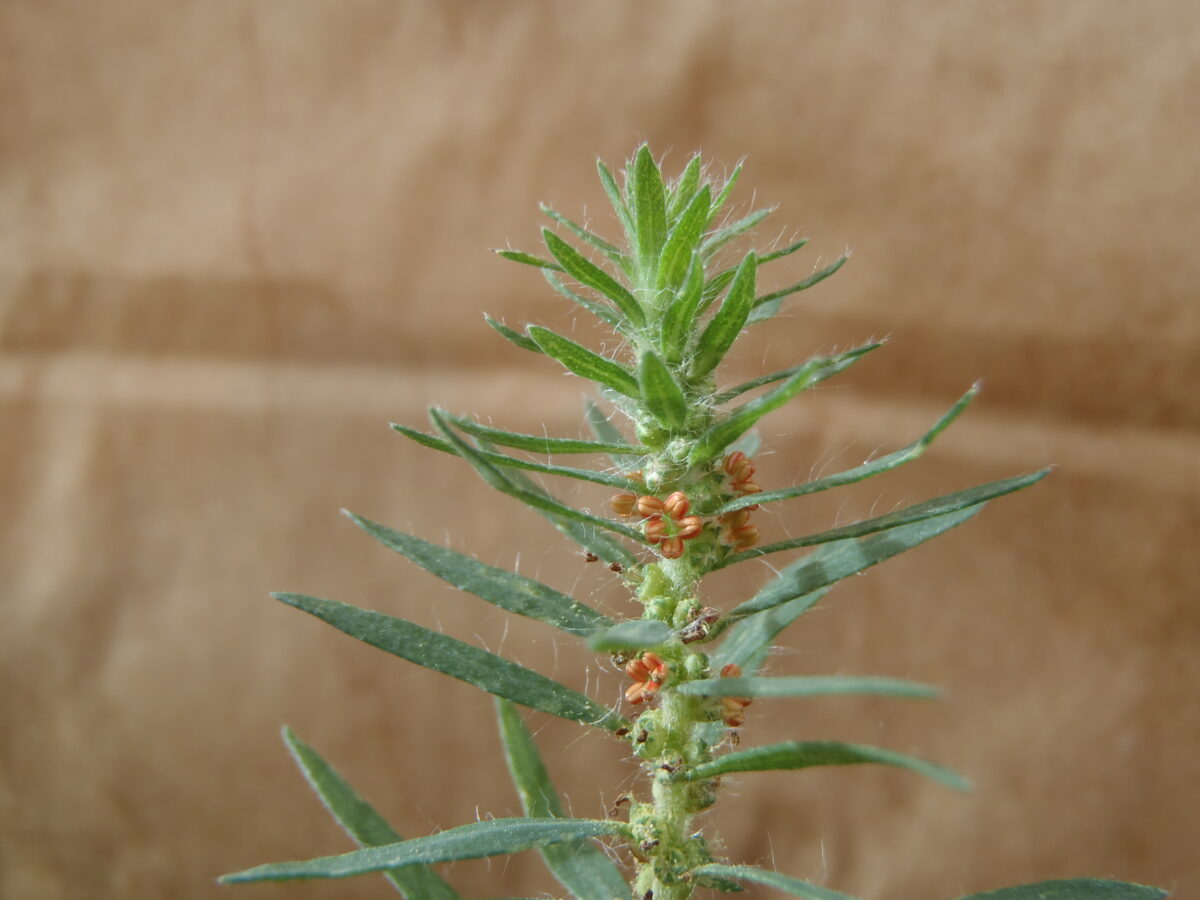Other common names: summer cypress, belvedere, burning bush, fireball, Mexican fireweed, belvedere, mock cypress, red belvedere, belvedere cypress, red belvedere, broom cypress



Bassia scoparia (L.) A.J. Scott = Kochia scoparia (L.) Schrad.
Identification of Kochia
Family: Goosefoot family, Chenopodiaceae
Habit: Tall, much branched, taprooted summer annual herb
Description: Cotyledons of kochia seedlings are stalkless, elliptical, 0.18 inch long by 0.1 inch wide and softly hairy, with dull green upper surfaces and sometimes bold pink or magenta on the underside. Stems are hairy and green to reddish in color. Young leaves are lanceolate to wide-thumb shaped, pointed at the tip, red-tinged underneath, gray-green above due to the presence of numerous soft hairs, and initially have a whorled leaf arrangement like a basal rosette. Mature plants are highly branching, 1–6.5 feet tall, pyramidal to round, and bushy, with a soft, airy texture. Plants look blue to gray-green during the growing season, turning red-green or red-purple in the fall. Stems are red tinged and more or less hairy. Alternate leaves are narrow, 1–2 inches long by 0.13–0.25 inch wide, and are attached by short stalks. Soft hairs are present on the untoothed leaf edges, leaf undersides and typically on upper leaf surfaces. Leaves decrease in size higher up on stems. The root system is a taproot with branched fibrous roots. The stem of the mature, dry plant breaks free from the root to become a tumbleweed in the fall. Green, petal-less, 0.13 inch-long flowers occur singly or in clusters of two to six in leaf axils of the upper stems or in short spikes with long, white hairs and a 0.13–0.5 inch-long, leaf-like bract below each flower cluster. Seeds are contained in papery bladders derived from the green portion of the flowers. Seeds are egg shaped with many irregularities and no bigger than 0.1 inch, with a gritty, bumpy, dull, grooved surface; they range in color from transparent brown with yellow spots to dark red-brown or black.
Similar species: Russian-thistle (Salsola tragus L.) has narrower, needle-like leaves at all stages compared to kochia. Forage kochia [Bassia prostrata (L.) A.J. Scott] is a perennial, semi-evergreen species with 1–5 inch-long, linear leaves. Common lambsquarters (Chenopodium album L.) has broader, diamond-shaped leaves and is a hairless species with a white or pink-dusted leaf surface, especially when the plant is young.
Management of Kochia
Kochia relies primarily on prolific seed production and abundant seedling emergence for population growth, suggesting that management of these life stages will have the greatest impact on controlling this species. Because kochia seeds survive for a short time in the soil, preventing seed production for just a single year will largely control even severe infestations. Two or three years of vigilance can essentially eradicate the population. Consequently, rotating fields into a hay crop for a few years should be highly effective for managing kochia. Winter cereals are good competitive crops when they establish a vigorous leaf canopy by the time kochia emerges in spring. Avoid uncompetitive crops such as flax or beans. Growing a fall-established triticale-legume cover crop mix in a wheat-fallow system in Kansas effectively suppressed kochia without adversely affecting the following wheat crop. Yellow sweetclover significantly reduced kochia population when grown as a green manure fallow in Alberta.
Kochia is more abundant in no-till than in conventional-tillage systems, in part because of its ability to germinate in cool soil associated with crop residue at the soil surface. Management including carefully targeted tillage operations were most effective for reducing kochia populations. Because seeds need to be within the top inch or less of soil to successfully emerge and because seeds buried more deeply often germinate and die, inversion tillage is an effective control measure. Because the peak of emergence occurs early in the spring, delaying tillage and planting will decrease the current year’s infestation, even if tillage is shallow. Cool-season crops like wheat, however, will compete better with kochia, a warm-season weed, when planted during the cool weather of spring.
Because kochia emerges only from the top inch of soil, tine weeding is effective against this weed in both small grains and row crops. For example, harrowing of spring wheat and barley with either a tine weeder or a spike-tooth harrow at the crop’s three-leaf stage gave 66% and 62% control of kochia, respectively. Spike tooth harrowing at both the three- and five-leaf stage increased control to 82%, but a second tine weeding at the five-leaf stage did not improve control. None of the weeding treatments affected yield of either crop despite about 19% damage when harrowing was done twice. Pre-emergence tine weeding or rotary hoeing would probably provide additional control. Due to its small seed reserves, kochia starts slowly, but it grows rapidly once established. Consequently, burying in-row kochia seedlings with soil as soon as the crop will tolerate it could be effective.
In the northern Great Plains, seeds mature after the time of small grain harvest. This indicates that many of the early maturing seeds could be captured during combine harvesting of grain and, with prompt cleanup of the field after harvest, could prevent further seed production that year. Plants remaining after grain harvest can produce many seeds, so destroy kochia re-growth before the first killing frost. Avoid irrigation practices that increase soil salinity, as this will favor kochia relative to crops. After a field has been cleaned up, a snow fence can prevent the majority of mature plants from rolling in from adjacent infested areas.
Ecology of Kochia
Origin and distribution: Kochia is native to eastern Europe and western Asia. It occurs throughout southern Canada and the United States except parts of the Southeast, but it is particularly a problem in the Great Plains and Intermountain West. In addition to North America, it has spread widely in Europe, China and Japan, and has been introduced into Africa, Argentina, Australia and New Zealand.
Seed weight: Population mean seed weights vary from 0.2–0.85 mg.
Dormancy and germination: Kochia seeds have little dormancy and germinate greater than 75% at temperatures from 41–95°F, but germination is inhibited at 104°F. Alternating temperature does not enhance germination. Germination is very rapid, with seedlings commonly breaking through the seed coat within 24 hours at 68–77°F. Light is not required for germination. Kochia seeds can germinate in soil that is too dry for establishment of drought tolerant crops, and kochia can also germinate in solutions of up to 10,000 parts per million salt. High salt conditions reduce germination less at high temperatures than at low ones. Kochia can germinate at a wide range of pH from 2–12.
Seed longevity: Most kochia seeds either germinate or die in their first year. In undisturbed soil, up to 3% can survive two to three years when buried at 12 inches, but survival is much poorer near the soil surface. In the western United States and Canada, seeds buried in fall had good viability in the early spring when emergence typically occurs, but they suffered high mortality over summer months and had low viability by fall. Seed placement from the soil surface to a depth of 4 inches had little effect on seed mortality in these experiments.
Season of emergence: Most seedlings emerge early in spring, but some emerge later following rains. In Colorado, for example, 80% of seedlings emerged between April 11 and June 20, with emergence commencing when the average daily air temperature was 49°F, a finding consistent with research showing emergence commencing when the soil temperature reached 50°F. Populations from several Great Plains states had different emergence patterns, suggesting different emergence biotypes that would require location-specific management tactics. Post-emergence herbicides have selected for late emerging biotypes.
Emergence depth: Seedlings emerge best from the top 0.4 inch, and few emerge from deeper than 0.8 inch. Seedlings establish better from seeds on the soil surface than at 0.1 inch.
Photosynthetic pathway: C4
Sensitivity to frost: Seedlings in spring have tolerated a nighttime temperature of 9°F, but six-week-old plants that were cold acclimated for three weeks did not survive 18 hours at temperatures of 22°F or lower.
Drought tolerance: Kochia is very drought tolerant, and historically infestations have tended to increase during drought periods to the exclusion of other weed species. Drought tolerance is partially due to an extensive root system; under favorable moisture conditions the roots penetrate 7 feet, and under drought conditions they can penetrate up to 16 feet. Kochia is less drought tolerant under high-salt soil conditions.
Mycorrhiza: Kochia is not mycorrhizal.
Response to fertility: Kochia is highly responsive to N, and its productivity continues to increase up to very high N application rates (480 pounds per acre). Plants can absorb up to 90% of available soil nitrogen. Kochia only responds to P when soil levels are very low, although very low soil N fertility increases the range of P application rates to which kochia responds. High soil P levels will suppress growth.
Soil physical requirements: Kochia is most common in dry pastures, rangelands and cropland with alkaline soils. It does not occur on highly acidic soils. It tolerates a wide range of soil types and is well adapted to saline soils.
Response to shade: Compared with cropped sunflowers, kochia is relatively intolerant of shade.
Sensitivity to disturbance: Kochia regrows profusely after cutting by producing branches from axillary buds. For example, when grown for hay it is typically mowed four times during the growing season. Plants that are cut off by a combine produce many seeds that remain in place since the truncated plant does not break off and tumble.
Time from emergence to reproduction: Kochia plants flower 57–109 days after emergence. It flowers in response to decreasing day length, with shorter light periods and longer times from emergence required for more southerly populations (e.g., New Mexico as compared to South Dakota).
Pollination: Kochia commonly self-pollinates but has a moderate rate of outcrossing by wind and bee dispersed pollen.
Reproduction: Kochia typically produces 10,000–30,000 seeds per plant, with the potential for up to 100,000 seeds per plant. Greater than 99.9% of seeds are retained on plants at wheat harvest, suggesting the potential for removal and destruction of seeds at harvest. However, plants re-growing following combine harvest of grain can produce 2,600–4,000 seeds each.
Dispersal: Mature kochia break off near the base of the stem and roll as tumbleweeds, dispersing seeds as they bounce along over long distances if unobstructed. As a result, kochia has the highest rate of spread of any introduced weed in the western United States. Some kochia seeds can pass through the rumen of cattle unharmed and can be expected to move about with the cattle and be spread with manure. The seeds also disperse in irrigation water.
Common natural enemies: Kochia appears to be free of damaging diseases and insect herbivores in North America, although grasshoppers do eat it.
Palatability: The palatability and nutritional value of kochia for livestock is better than that of some grasses, such as bromegrass, but less than that of alfalfa. Plants contain up to 25% protein, and biotypes have been investigated as forage species on arid saline soils, which are not suitable for common forages. Kochia can be toxic to livestock if it composes more than 50% of the diet for several weeks, particularly if it is fed fresh. Note that “forage kochia” [Bassia prostrata (L.) A.J. Scott] is a perennial shrub suitable for forage in western rangeland and should not be confused with the weedy annual kochia described here.
Note: Kochia pollen is an important allergen and a common cause of allergic sensitization.
Summary Table of Kochia Characteristics
| Kochia | ||||||||
|---|---|---|---|---|---|---|---|---|
| Growth habit | Seed weight (mg) | Seed dormancy at shedding | Factors breaking dormancy | Optimum temperature for germination (F) | Seed mortality in untilled soil (%/year) | Seed mortality in tilled soil (%/year) | Typical emergence season | Optimum emergence depth (inches) |
| tall, branched | 0.20–0.85 | No | none | 68–77 | 97–100 | na | spring | 0-0.4 |
| Photosynthesis type | Frost tolerance | Drought tolerance | Mycorrhiza | Response to nutrients | Emergence to flowering (weeks) | Flowering to viable seed (weeks) | Pollination | Typical & high seed production (seeds per plant) |
| C4 | moderate | high | no | high | 8–16 | – | self, can cross | 20,000 & 100,000 |
Table Key
General: The designation “–” signifies that data is not available or the category is not applicable.
Growth habit: A two-word description; the first word indicates relative height (tall, medium, short, prostrate) and second word indicates degree of branching (erect, branching, vining).
Seed weight: Range of reported values in units of “mg per seed.”
Seed dormancy at shedding: “Yes” if most seeds are dormant when shed, “Variable” if dormancy is highly variable, “No” if most seeds are not dormant.
Factors breaking dormancy: The principle factors that are reported to break dormancy and facilitate germination. The order of listing does not imply order of importance. Abbreviations are:
scd = seed coat deterioration
cms = a period subjected to cold, moist soil conditions
wst = warm soil temperatures
li = light
at = alternating day-night temperatures
ni = nitrates
Optimum temperature range for germination: Temperature (Fahrenheit) range that provides for optimum germination of non-dormant seeds. Germination at lower percentages can occur outside of this range. The dash refers to temperature range, and the slash refers to alternating day/night temperature amplitudes.
Seed mortality in untilled soil: Range of mortality estimates (percentage of seed mortality in one year) for buried seeds in untilled soil. Values were chosen where possible for seeds placed at depths below the emergence depth for the species and left undisturbed until assessment. Mortality primarily represents seed deterioration in soil.
Seed mortality in tilled soil: Range of mortality estimates (percentage of seed mortality in one year) for seeds in tilled soil. Values were chosen for seeds placed within the tillage depth and subjected to at least annual tillage events. Seed losses are the result of dormancy-breaking cues induced by tillage, germination and deterioration of un-germinated seeds.
Typical emergence season: Time of year when most emergence occurs in the typical regions of occurrence for each weed. Some emergence may occur outside of this range.
Optimum emergence depth: Soil depths (in inches below the soil surface) from which most seedlings emerge. Lower rates of emergence usually will occur at depths just above or just below this range.
Photosynthesis type: Codes “C3” or “C4” refer to the metabolic pathway for fixing carbon dioxide during photosynthesis. Generally, C3 plants function better in cooler seasons or environments and C4 plants function better in warmer seasons or environments.
Frost tolerance: Relative tolerance of plants to freezing temperatures (high, moderate, low).
Drought tolerance: Relative tolerance of plants to drought (high, moderate, low).
Mycorrhiza: Presence of mycorrhizal fungi. “Yes” if present; “no” if documented not to be present, “unclear” if there are reports of both presence and absence; “variable” if the weed can function either with or without, depending on the soil environment.
Response to nutrients: Relative plant growth response to the nutrient content of soil, primarily N, P, K (high, moderate, low).
Emergence to flowering: Length of time (weeks) after emergence for plants to begin flowering given typical emergence in the region of occurrence. For species emerging in fall, “emergence to flowering” means time from resumption of growth in spring to first flowering.
Flowering to viable seed: Length of time (weeks) after flowering for seeds to become viable.
Pollination: “Self” refers to species that exclusively self-pollinate, “cross” refers to species that exclusively cross-pollinate, “self, can cross” refer to species that primarily self-pollinate, but also cross-pollinate at a low rate, and “both” refers to species that both self-pollinate and cross-pollinate at relatively similar rates.
Typical and high seed production potential: The first value is seed production (seeds per plant) under typical conditions with crop and weed competition. The second value, high seed production, refers to conditions of low density without crop competition. Numbers are rounded off to a magnitude that is representative of often highly variable reported values.
Further Reading
Eberlein, C.V. and Z.Q. Fore. 1984. Kochia biology. Weeds Today 15: 5–7.
Friesen, L.F., H.J. Beckie, S.I. Warwick and R.C. Van Acker. 2009. The biology of Canadian weeds. 138. Kochia scoparia (L.) Schrad. Canadian Journal of Plant Science 89: 141–167.
Moore, J., J. Dodd, S. Lloyd, C. Hanson, T. Grice and J. Thorpe. 2003. Kochia (Bassia scoparia). Weed Management Guide.
Petrosino, J.S., J.A. Dille, J.D. Holman and K.L. Roozeboom. 2015. Kochia suppression with cover crops in southwestern Kansas. Crop, Forage & Turfgrass Management 1(1): 1–8.
Schwinghammer, T.D. and R.C. Van Acker. 2008. Emergence timing and persistence of kochia (Kochia scoparia). Weed Science 56: 37–41.

